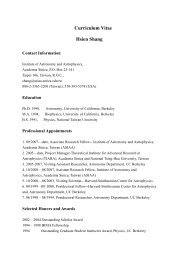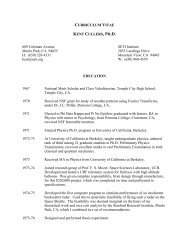SETI Institute Frequently Asked Questions To help you quickly find ...
SETI Institute Frequently Asked Questions To help you quickly find ...
SETI Institute Frequently Asked Questions To help you quickly find ...
- No tags were found...
Create successful ePaper yourself
Turn your PDF publications into a flip-book with our unique Google optimized e-Paper software.
theory of cosmic evolution that predicts that life is a<br />
natural phenomenon likely to develop on planets with<br />
suitable environmental conditions. Scientific evidence<br />
shows that life arose on Earth relatively <strong>quickly</strong>,<br />
suggesting that life will occur on similar planets orbiting<br />
sun-like stars. With the recent discoveries of<br />
extrasolar planetary systems, and the suggestive evidence<br />
that life may once have existed on Mars, this<br />
scenario appears even more likely.<br />
Additionally, one should keep in mind that we are<br />
only one planet around a very ordinary star. There are<br />
roughly 400 billion other stars in our Galaxy, and<br />
nearly 100 billion other galaxies. It would be extraordinary<br />
if we were the only thinking beings in all these<br />
enormous realms.<br />
What is the Drake Equation<br />
The Drake Equation, originally developed as an<br />
agenda for a 1961 scientific meeting, provides a way<br />
of estimating the number of intelligent civilizations<br />
existing in our galaxy that might be broadcasting<br />
signals. Among the factors considered are the number<br />
of sun-like stars in our galaxy, the fraction of habitable<br />
planets supporting communicating civilizations,<br />
etc. When these various factors are multiplied together<br />
one can compute N, the number of transmitting<br />
civilizations. Unfortunately, many of the factors are<br />
message any more than a radio disk jockey knows<br />
that <strong>you</strong>’ve tuned in his show. For the extraterrestrials<br />
to<br />
Why do <strong>SETI</strong> at all<br />
There are many reasons, including such practical<br />
considerations as the technological spinoff. The signal<br />
processing techniques used for Project Phoenix have<br />
already been applied to the detection of breast cancer.<br />
But <strong>SETI</strong> research is first and foremost pursued because<br />
it is designed to answer questions that previous<br />
generations could only ask. How do we fit into the<br />
biological scheme of the cosmos Is intelligent life a<br />
rare event or a common one in the universe Can<br />
technological civilizations last for long periods of<br />
time, or do they inevitably self-destruct or die out for<br />
some other reason If we could understand any signal<br />
that we detect, there’s always the possibility that we<br />
could be presented with enormously valuable knowledge.<br />
It is likely that any civilization we discover will<br />
be far more advanced than ours, and might <strong>help</strong> us to<br />
join a galactic network of intelligent beings. But even<br />
III. Antecedentes.<br />
¿Por qué pensamos que hay vida “ahí fuera”<br />
Durante el último medio siglo, los científicos han<br />
desarrollado una teoría de la evolución cósmica que<br />
predice que la vida es un fenómeno natural que tiende<br />
a desarrollarse en planetas con las adecuadas<br />
condiciones ambientales. La evidencia científica<br />
muestra que la vida en la tierra apareció de una<br />
manera relativamente rápida, lo que sugiere que<br />
podría ocurrir lo mismo en planetas similares con<br />
estrellas del tipo del sol. Con el reciente<br />
descubrimiento de sistemas planetarios extrasolares, y<br />
la sugerente evidencia de que podría haber habido<br />
vida en Marte, este escenario parece incluso más<br />
probable.<br />
Además, uno debería tener en cuenta que sólo somos<br />
un planeta orbitando alrededor de una estrella<br />
bastante ordinaria. Hay aproximadamente<br />
cuatrocientos mil millones más de estrellas en nuestra<br />
galaxia, y cerca de cien mil millones de galaxias.<br />
Sería extraordinario que fuésemos los únicos seres<br />
pensantes en un universo tan enorme.<br />
¿Qué es la ecuación de Drake<br />
La ecuación de Drake, originalmente desarrollada<br />
como una agenda para un encuentro científico de<br />
1961, provee una manera de estimar el número de<br />
civilizaciones inteligentes de nuestra galaxia que<br />
podrían estar emitiendo señales. Entre los factores se<br />
encuentra el número de estrellas del tipo del sol en<br />
nuestra galaxia, la fracción de planetas habitables<br />
capaces de soportar civilizaciones comunicativas, etc.<br />
Multiplicando estos factores se calcula N, el número<br />
de civilizaciones que podrían estar transmtiendo.<br />
Desafortunadamente, muchos de los factores son casi<br />
desconocidos, por lo que las estimaciones de N<br />
oscilan entre 1 (es decir, estamos solos en la galaxia)<br />
hasta miles o incluso millones.<br />
Y a fin de cuentas, ¿para qué sirve el <strong>SETI</strong><br />
Existen varias razones para realizar esta<br />
investigación, incluyendo consideraciones prácticas<br />
de desarrollo tecnológico. Las técnicas de<br />
procesamiento de señales usadas en el proyecto<br />
Phoenix se están utilizando ya para la detección del<br />
cáncer de mama. Pero la investigación <strong>SETI</strong> se sigue,<br />
sobre todo, porque está concebida para contestar a<br />
preguntas que las generaciones precedentes sólo<br />
podían elucubrar. ¿Cuál es nuestro lugar en el<br />
esquema biológico del Cosmos La vida inteligente,<br />
¿es algo raro o común en el universo Las













